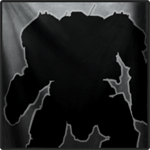 Yeonne Greene, on 18 June 2016 - 04:54 PM, said:
Yeonne Greene, on 18 June 2016 - 04:54 PM, said:
If I tell you to take a rifle and shoot a target, from 300 meters, that is only 5 cm wide and shoot another one that is 20 cm wide, you have a higher probability of a hit on the latter than the former. The relative size is 1:4. Now, if the smaller target is now 20 cm and the larger one is 80 cm - note that it's still 1:4 - then the smaller one is now dramatically easier to hit.
Now, your next argument would be that the 80 cm target is also easier to hit. However, you are not accounting for skill. There is a certain point where the skill of the shooter makes targets above X size trivial to hit. If the level of skill possessed requires targets to be 5 cm or lower to be difficult, then the only target that "lost out" was the smaller one; the larger one was always easy to hit.
This has been an issue in every discussion where we've talked about scale. An Atlas is a barn door. Taking sides off is trivial for me and I would wager most players who aren't totally hopeless cases. A Centurion is actually a bit harder. If the Atlas gets bigger and the Centurion is now the size of the old Atlas to remain proportional, the Centurion becomes as easy to remove components off of as the Atlas in terms of required precision, and actually easier when you account for the lower amount of registered damage it can withstand. The only way these squishy 'Mechs survive is by having agility (fast torso twisting, good run speed, good turn speed) in combination with sizing (and hit-box size ratios) that facilitates the use of agility to spread the damage around. If the size changes and the agility doesn't scale with it, then you have a net loss. And even then, there's only so much you can do with agility and some of these 'Mechs won't really feel like 'Mechs if we let them twist any faster. We can add more hit-points, but really...where do you draw the line? At some points it's just more effective to let the 'Mech stay smaller.
I mean, this angle is why the Locust has always been bad. It's too big for how fast it moves and how much armor it has, being the size of a Jenner currently. It is way too easy to hit for people at T2 and T1 levels and it doesn't hit hard enough itself to make its fragility a worthwhile consideration. Now that it is getting super tiny, it might be worth something at the high-end.
 Yeonne Greene, on 18 June 2016 - 04:54 PM, said:
Yeonne Greene, on 18 June 2016 - 04:54 PM, said:
If I tell you to take a rifle and shoot a target, from 300 meters, that is only 5 cm wide and shoot another one that is 20 cm wide, you have a higher probability of a hit on the latter than the former. The relative size is 1:4. Now, if the smaller target is now 20 cm and the larger one is 80 cm - note that it's still 1:4 - then the smaller one is now dramatically easier to hit.
Accepted.
However, in THIS discussion, we're not talking about the perspective of two items as viewed from a 3rd completely independent viewpoint which doesn't change relative to the other items.
We're talking about the view point from either of two items which change interdependently.
For the sake of your example, using my previous comparison picture to illustrate your point... if you're the tree, and both mechs are enlarged, both mechs are easier to hit. That's your argument. And that's a point conceded. This is absolutely the case.
When you enlarge the two targets in your example, you're changing their relative scale to the shooter. The targets are larger, but the shooter is the same size. The absolute scale has not changed. By the shooter's perspective, no other things having changed, the targets are simply larger. But, from the perspective of the two targets, the opposing target hasn't changed sizes... the world has merely shrunk a little, including the independent 3rd party (the shooter, or the tree).
But noone in this argument is taking the perspective of the tree. We're in either of the two mechs, or in your example, the targets. And from the each of the targets' perspectives, the opposing target is exactly the same size as it was before.
 LordKnightFandragon, on 18 June 2016 - 04:37 PM, said:
LordKnightFandragon, on 18 June 2016 - 04:37 PM, said:





























